“The Puppets Are Alright” by The Finger Players
and I know the outgoing artistic directors will be alright too
Just over three years ago, I sat in The Finger Players’ studio with the company’s incoming co-artistic directors, Ellison Tan and Myra Loke. They picked absentmindedly at their takeout lunches, preoccupied with their impending responsibilities. We spoke for at least an hour, and I wrote a long essay about the transition the company was going through, and the undercurrent of anxiety that Ellison and Myra were wrestling with as they steeled themselves for this change. They listed out some of these anxieties: imposter syndrome, getting the company’s wobbly finances in order, having to put their emergent collective (The Wanderlings, featuring work for babies) on hold. A global pandemic was not one of them.
One of the aspects of puppetry we discussed during that transition interview was the sense of effortlessness The Finger Players had been channelling in their work until that point. “They are constantly making magic look like it’s very simple,” Myra marvelled. Processes of making are, of course, not simple or magical at all—and the process of unmaking and remaking a company and its identity far less so. The chaos and stasis of the pandemic masked a lot of the processual work that artists and companies embarked on, whether by choice or by constraint, to rethink the foundations of their creative practice. In my longer-term conversations with Ellison, she remarked that the pandemic had also shielded them, in a way, from the expectation to produce blockbuster pieces of puppet theatre. They could focus on the spine of their directorship—The Makers Lab, dedicated to nurturing puppet and object builders and developing their artistry and craft in a rigorous way. Lab work often isn’t sexy work; experimenting can be tedious, repetitive, frustrating—both for the maker and the spectator. It’s no surprise that we as audience members don’t usually get to see this work, and that productions featuring the slow chisel of this processual work often don’t get the same kinds of traction that the polished, high-sheen productions do.
In Alva Gotby’s new book They Call It Love: The Politics of Emotional Life (2023, hot off the presses!), she writes about how emotional labour often becomes less visible when it is well done:
“Emotional labour is difficult to think about since the better it is done, the more it appears as non-work, both for the labourer and for the recipient of emotional care. All labour may involve effort on the side of the labourer, yet such exertion might appear as merely a natural expression of the labouring subject. In emotional labour processes in particular, the result of the work is often invisible as a product and comes to appear as an aspect of the personality of the worker. As Sophie Lewis argues, in these forms of labour, ‘a feminized person’s body is typically being further feminized: it is working very, very hard at having the appearance of not working at all’.”
This invisibility often extends to the kind of labour that backstage workers and behind-the-scenes workers do—stage managers, production managers, access workers, wardrobe assistants, everyone who’s had to navigate and smooth over meltdowns, body image anxiety, overturned rehearsal schedules, or the constantly shapeshifting landscapes of childcare and eldercare. I think of makers as part of this invisibilised process too. While it isn’t always necessary to render these challenges invisible, they often are; these processes of caregiving aren’t usually considered part of the aesthetics of performance experience, the tiny bit we spectators get to see. If the previous configuration of The Finger Players was “constantly making magic look like it’s very simple”, or “working very, very hard at having the appearance of not working at all”—then this period of the company’s life has traded the appearance of effortlessness for the hard, effortful part of making and doing.
The inaugural cycle of The Makers Lab turned the puppet-making process inside out while also reflecting on the performance history of The Finger Players, and featured designer and maker Sim Xin Feng’s puppetry work in the production Little Mournings (March 2021, which I loved). The second featured designer Loo An Ni and focused on sustainability and the afterlives of puppet-making materials and resources, culminating in No Disaster on This Land (February-March 2022). And we arrive here at the final instalment of the Lab under Ellison and Myra’s tenure, The Puppets Are Alright (February 2023).
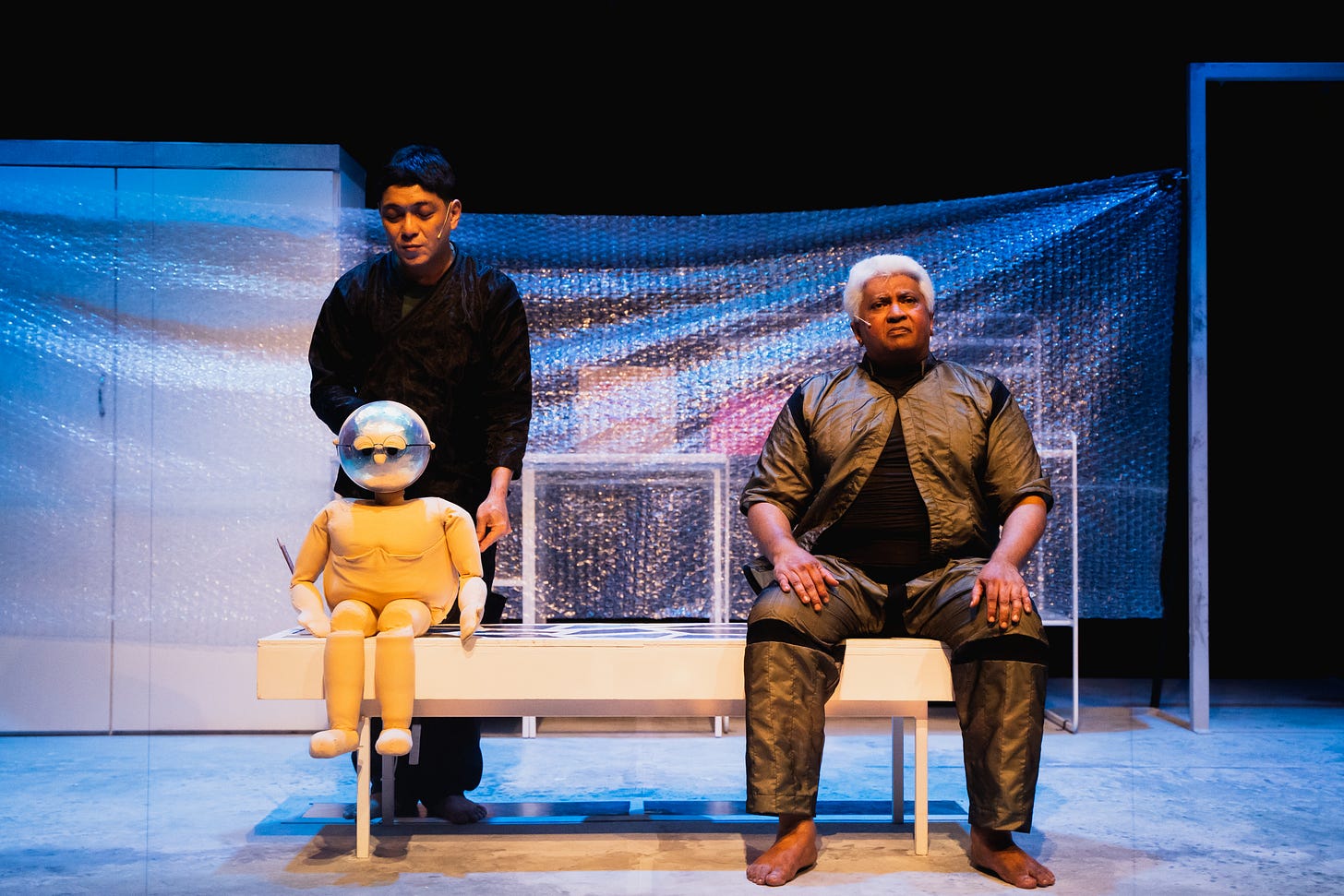
The Puppets Are Alright is a triple bill of playlets featuring puppets from each of the featured makers in The Makers Lab. It brings together all the strands of making that The Finger Players has given a platform to over the past three years, and each puppet operates and is manipulated in varied, surprising and—in certain heartstopping moments—transcendent ways. The playlets all feel brief, like sketches for a larger possibility rather than the thing itself, but I came ready to embrace this sense of working from a draft, the sense of turning a phrase or part of an object over in the palm of your hand, feeling where the edges might grow or expand. This piece of writing is my own way of making sense of the playlets in the broader context of my personal history with The Finger Players and the people who constitute this beloved company.
Each of the playlets was written and/or directed by a person instrumental to the leadership of the company, beginning with former company director Chong Tze Chien (My Father the AI Machine), whose vision of a puppet-oriented theatre company for adults propelled The Finger Players to stardom, but also introduced longer-term questions about the sustainability of a company that rested solely on the shoulders of an individual’s reputation and competencies. We have a second piece by Oliver Chong (Parting), the incoming artistic director, whose preoccupations with difficult emotion and the internal affective landscapes of masculinity come to the surface very strongly. And then we conclude with The Bench by outgoing joint artistic directors Ellison Tan and Myra Loke, a tender meditation on solo parenthood and a young man’s coming of age. Each piece occupies the same set (by Azy Alias)—an austere domestic interior featuring a kitchen countertop and some cupboards—and occasionally recycles the same props, to different effects. I think about the The Finger Players as something like this set, housing and holding all of these different creative voices and directions, welcoming minor adjustments while maintaining an overall sense of structure.
**Spoiler alert—since the run has concluded I’ll be going into some detail with the plot points of each work.**
Tze Chien’s long-time preoccupations with death and mortality find new skin in My Father the AI Machine (directed by Liew Jia Yi). The piece knits together contemporary anxieties around AI and platforms such as ChatGPT with the perennial “cruel optimism” of the Singaporean dream. In her 2011 book of the same name, literary scholar Lauren Berlant coined the term to describe the experience of “optimistic attachment” to something—an object, an aspiration, a romantic relationship, anything—where you expect that “this time, nearness to this thing will help you or a world to become different in just the right way”. But this thing really just ends up crushing you, and “becoming an obstacle to your flourishing”. If only I could just get that BTO to get some independence from my family. If only I could just get promoted so that I can finally achieve some work-life balance. If only I could just marry this person for a sense of romantic fulfilment (and all the institutional benefits that come with it).
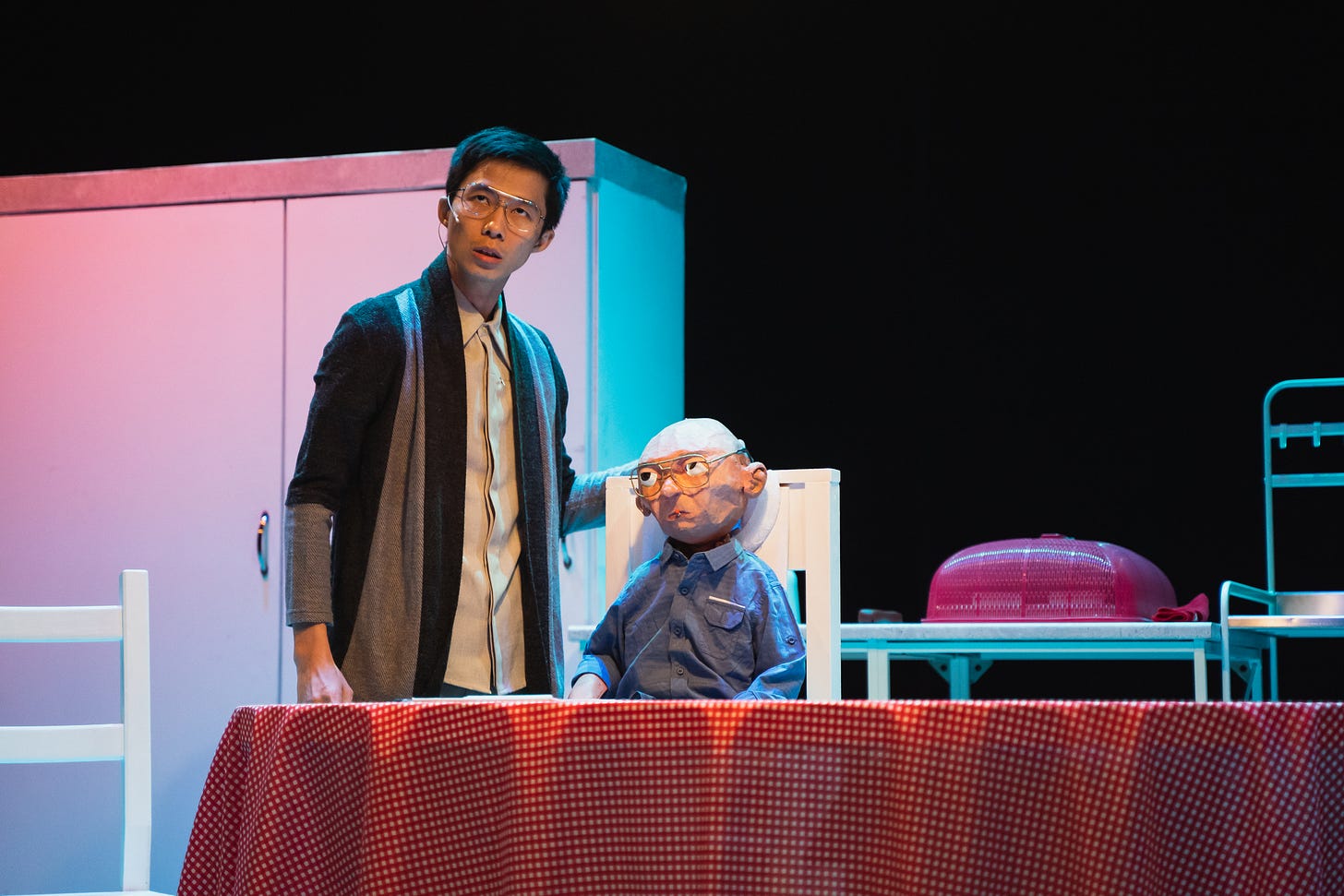
In the case of My Father the AI Machine, the single working-class mother (played by Doreen Toh) at the core of the play possesses an intractable optimism about upgrading the robot husk containing the state-sanctioned consciousness of her late husband. She works herself to the bone, juggling three jobs and bringing up a young son (Neo Hai Bin), scrimping and saving to get just the tiniest of upgrades to an object that may or may not even be housing the person she so deeply desires and mourns. Her son finds the robot vaguely novel at first, but as the decades pass, his resentment for this object and the person it represents—with whom he had no relationship—begins to severely corrode his relationship with his mother.
Sim Xin Feng’s puppet (which you might recognise from Little Mournings) is an eerie presence on stage, silent and static save for the glow and flicker of its eyes, sitting like a false idol at the dusty altar of the dining table. This makes every single one of its movements carry significant weight. Halfway through the playlet, and when the most significant rupture between mother and son takes place, the robot is “upgraded”—but not in the way either one of them wanted. The mother wants to give the robot a mouth; the son wants to go on a holiday to Europe for his 21st birthday. She ends up squandering the money on a compromise that manages to be both absurdly funny and terribly sad—she can’t afford a mouth, so she installs a mechanism that will allow the robot to print out reams of text in response to written prompts, unravelling ceaselessly from a horizontal slit in its chest. The son, his dreams of a backpacking holiday gone up in robot flames, is only beginning to recognise the cruelty of his mother’s optimism.
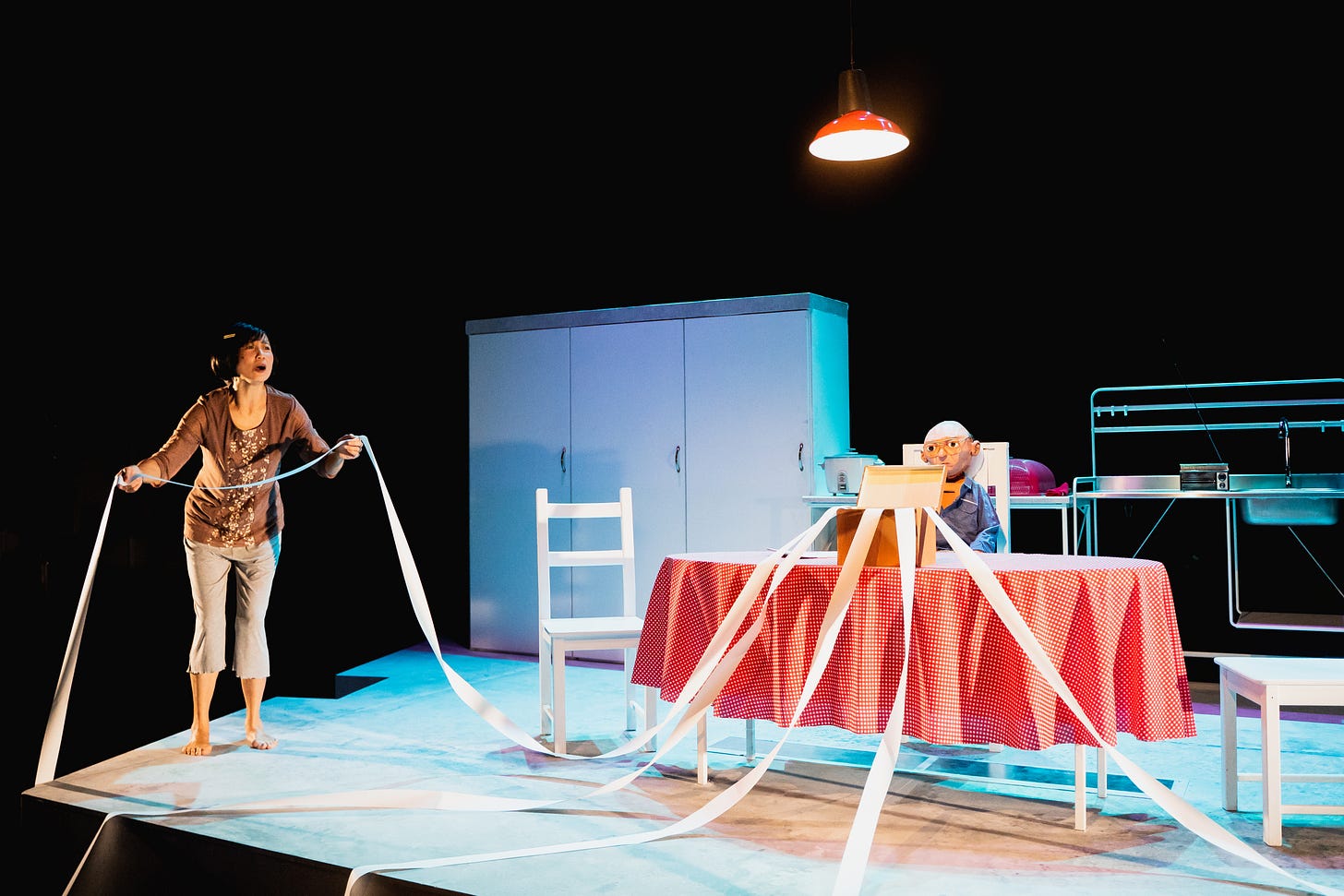
There’s a very neat “twist” at the end of the playlet that is telegraphed relatively strongly from the start, giving the entire work a Hitchcockian undertow. (Think Psycho, but make it Singapore.) I’m still not sure I personally needed that neat of a twist to tie up the work. I much preferred its morbidly funny and achingly sad observations of grief in Singapore, a grief not only for relationships unmended and conversations unfinished, but also for the trauma around these family connections that are transmitted from one generation to the next without a robot shell to house them in a way that might render them visible. The robot father, with its wide-set eyes and glacial gaze, clogged up with all the words it wanted to say but never did.
**content warning: descriptions of violence against women, including some gore (scroll quickly till you see bold text marking the end of this section)**
These relationship ruptures carry over to Oliver Chong’s Parting, which I approach here with a huge sense of trepidation. This work troubled me deeply. It’s a nonverbal piece, where the lights go up on a male (human) protagonist (played by Alvin Chiam) hunched over at a coffee table, surrounded by empty cardboard boxes, swigging alcohol, and scribbling away at a letter. He’s tormented by three demon-like feminine spirits (Angelina Chandra, Jo Kwek, Rachel Nip), black-clad and cackling, who emerge from the row of cupboards behind him, milking the jump-scares at every opportunity (they definitely succeeded, judging from the shrieks of the dozens of teenage students who were at the show). At this point I’m wondering—is this supposed to be a kind of literal metaphor for his tormented mental health?
Then the man opens the cupboards fully. And the emergent psychological horror tropes are rearranged completely when we realise that, hanging up on various meat hooks, are the body parts of what is very obviously a half-naked, decapitated puppet woman. It only becomes clearer later on, when the puppet is reconstituted, that this man has not literally murdered and dismembered this woman, but that it’s a kind of gory allegory for his ex-wife’s departure and the end of his marriage. I shrink into myself a little bit, seeing a female puppet reduced to her appendages, dressed only in underwear, the female form doubly objectified as a figure of blame and shame. She resembles a cast off sex doll, and is manipulated by the ensemble of demoness women/tormenting spirits, which adds to the trope of the monstrous feminine without doing very much to subvert it. The puppet reclaims a tiny bit of agency at the end, to inflict a final act of violence, but at what cost? For most of the work, she’s assembled and disassembled, or crumpled on the floor, or stumbling jerkily across the stage. She’s the Frankenstein of our male protagonist’s revenge fantasy, reanimated in his own specific vision of how the relationship ended.
We’re confronted by brutal violence against both cis and trans women on an almost daily basis—just think of the current media furore and morbid fascination around the horrific murder of Hong Kong socialite Abby Choi. Women are also avid consumers of the true crime genre, mostly because they know they’re the most likely victims of these acts of violence, and are most drawn to work where female victims manage to get away—and also because women just live with a baseline level of fear in our daily lives from anticipating these acts of aggression and doing our best to mitigate situations where that might be the case. Domestic and intimate partner violence plays out so frequently in the world we know that I almost feel like we have some kind of duty to see them play out differently on stage, to at least imagine different ways of relating to each other.
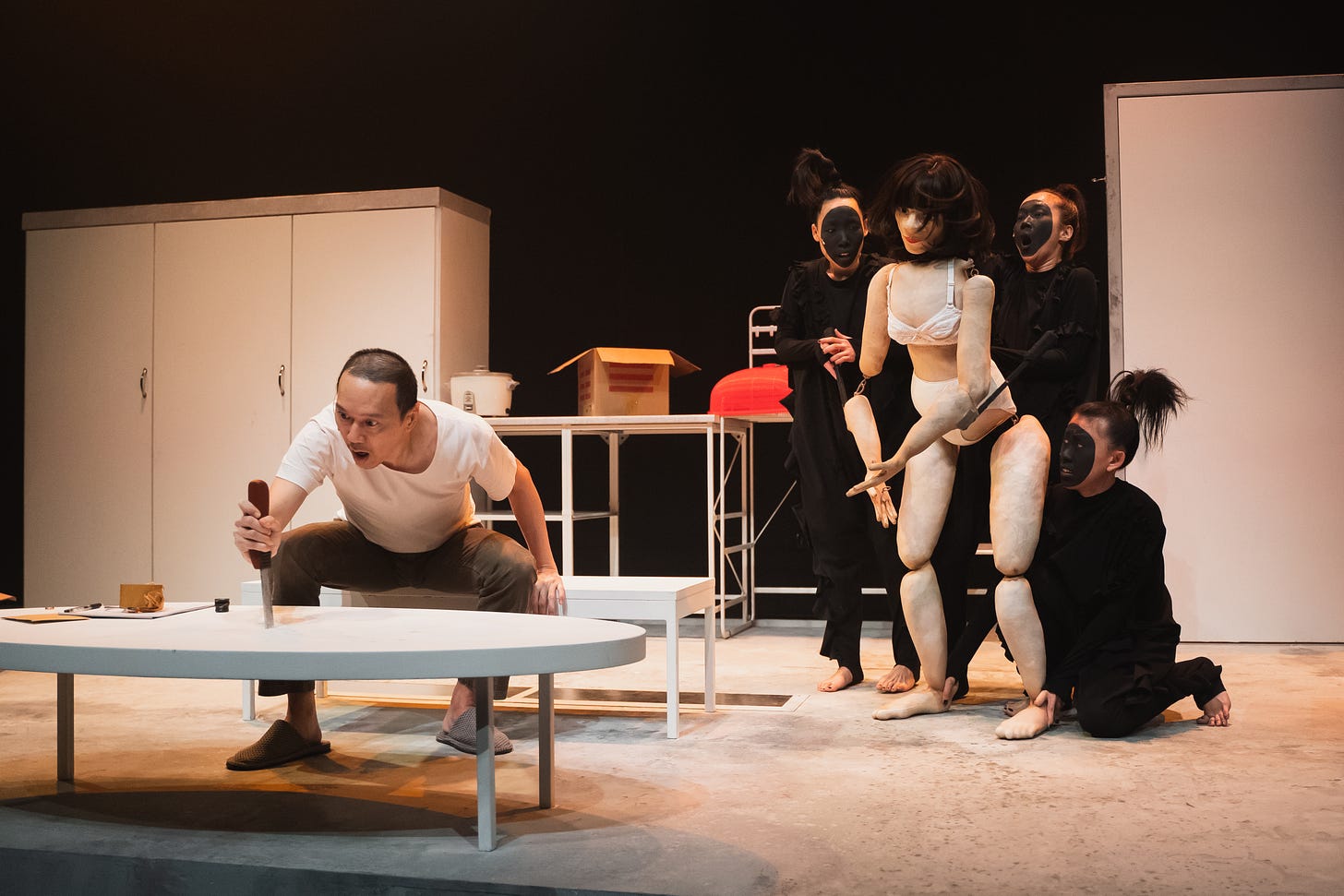
**content warning ends**
It was a relief to arrive at the final playlet of the night, The Bench, featuring the most recent of The Makers Lab’s puppets, Paul, designed and constructed by Marilyn Ang. It’s a playlet I have a soft spot for, even if it feels like the beginning of something rather than a fully-formed work. There’s an emergent shape to this piece—and the surprising, precious puppet at the centre of it—that allowed the work to ease itself into a part of my heart I had forgotten. Paul begins as an infant cradled by a single father (played by T. “Sasi” Sasitharan, returning to the stage!). Paul is operated and voiced by Ian Tan, whose gravitational pull as a performer gathers all of us into his orbit, from his gurgling baby coos and cries to the spine-tingling modulation of his voice as Paul becomes a frustrated teen and, eventually, a resigned adult. We get a kind of long exposure shot of the relationship between Paul and his father, anchored by the lone bench in the middle of the stage. I’m still not quite sure what the bench represents—a literal shared space, or an imagined connection?—but somehow that feels secondary, because it binds them together nonetheless, and allows both parent and child to self-soothe at every juncture of their rupturing relationship. The bench produces various tones depending on how the characters place their palms on its surface, and together they can create consonant or dissonant melodies, offering up fragments of music as an invitation to connect—or as parts of conversations gone unsaid.
Throughout the work, we see the Father figure attempting to insulate Paul from difficulty—whether that’s the absence of any mother figure, or failing a spelling test in school—by swaddling the boy in quotes and stories recycled from the literary canon (most prominently, Homer’s Iliad). These narratives thrill a young Paul at first, but then he begins to realise that nothing his father has offered him is “original”, and concludes that the life he is living must be a lie. There’s a delicate fragility to Paul that threads through the work, from the silvery paint that shimmers on the globe of his head, to the bubbles that emerge from various parts of his body: his mouth, his chest—streams of bubbles that end up settling into sculptural clusters all over the stage before they pop and dissolve. As Paul moves through the various life stages, the gleaming, reflective sheen of his head (a little like an astronaut’s helmet) becomes much more pronounced, particularly in contrast to the spongy beige quality of his body and limbs.
How do we decouple our vulnerable, newly-formed selves from the way our parents shape our identities and the ways in which we connect with the rest of the world? How might parents offer their children independence and protection at the same time? This cleaving of the parent-child relationship is something that happens to all of us, and that most of us manage to navigate, but in Paul’s case, the betrayal he feels at his father’s well-intentioned construction of an imagined world is both irrevocable and irreparable. The Bench asks these questions philosophically, but my assumption (and I may be wrong!) is that these themes find their source in the case of the “Bubble Boy”, David Vetter, who had to live the entirety of his 12-year life in a sterile bubble because he was severely immunocompromised. What might it mean to feel emotionally immunocompromised, to be exceptionally susceptible to the affective infection of the world? This is something I wish the playlet had excavated further, beneath the wilfully thick, lyrical prose of the playtext (through which we do get a small sense of how Paul has been shrouded by his father’s use of language). The piece is trying to convey so much, and it makes me want to experience this as a lengthier, fully-fleshed work.
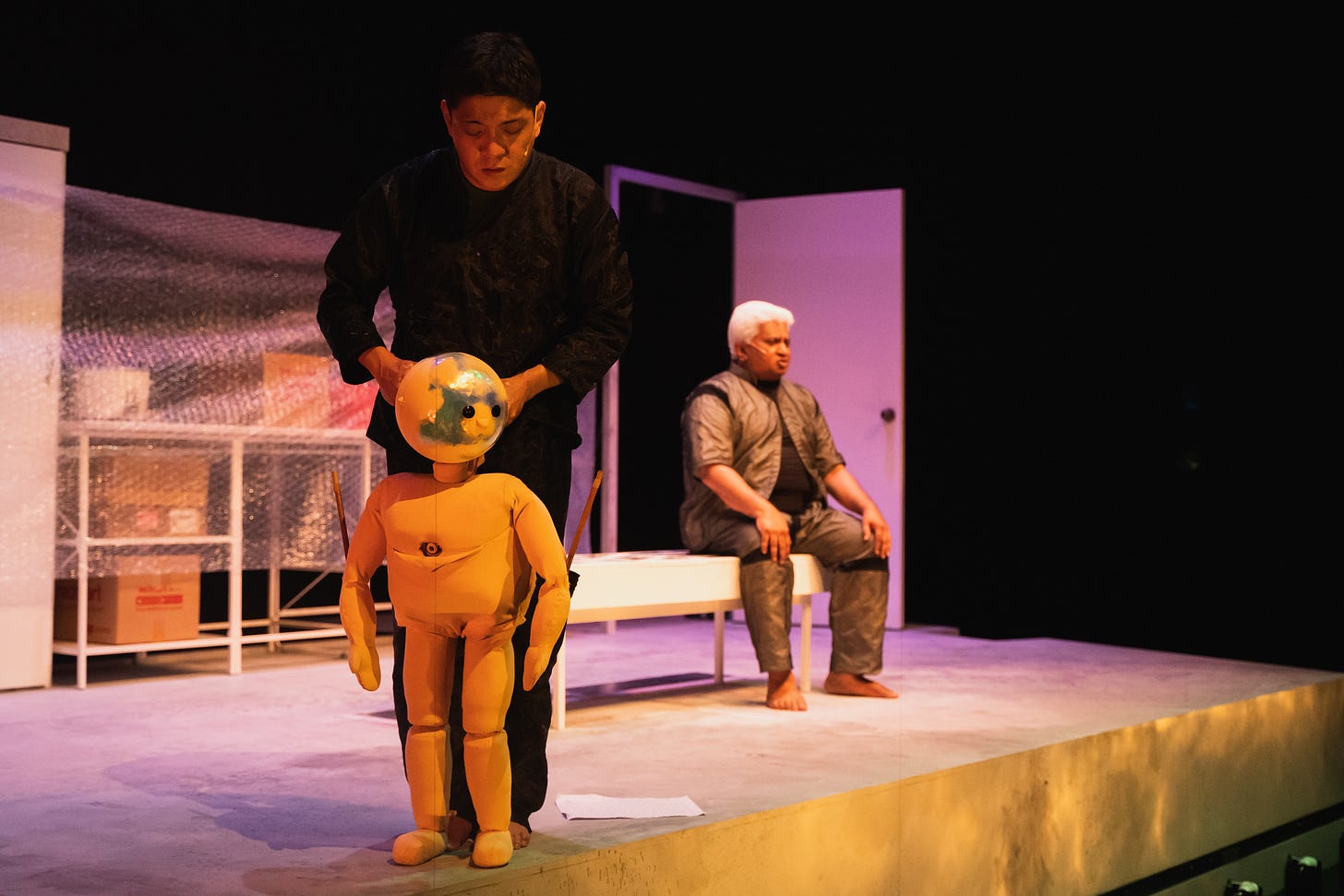
Are the puppets alright? They’ve been through a lot. It also takes a certain kind of faith to strip away the trimmings and trappings of performance and allow us a glimpse of the internal and emergent architecture of these puppets—and bill it as a mainstage, main season show. The Finger Players has had to turn itself inside out over the past three years, and even as it disassembles and reassembles itself (and will continue to do so, every three years), the company is introducing us to its more varied ways of working, and perhaps how we as an audience might adjust our expectations and desires of the group as it shapeshifts over time. I suppose the audience will learn to be alright, even as ticket purchasing habits and the kinds of shows the public desires to watch have also evolved with the pandemic. I think of Paul, floating across the stage, drastically reconsidering every inch of his life—and how we are also emerging from a strange temporal rupture in our lives and reconsidering the ways in which we interact with performance and the world. I wouldn’t say I’m always optimistic. But I would say I’m hopeful.
I watched The Puppets Are Alright on 24 February 2023 (8pm show).
Hello from the changeover between PhD dissertation chapters! This is definitely a pivot back to “regular programming”, but this newsletter has become pretty random anyway, so let’s see what inspires me next.


